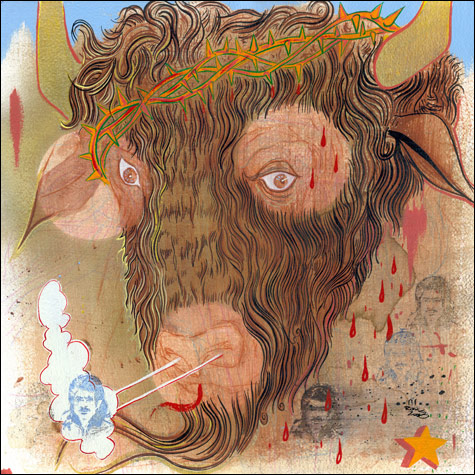After his immigration fantasy, he tells me, "I started thinking of people who were already here and had labels put on them." A year ago, he began to do drawing-paintings with buffaloes and cartoon Indians inspired by the Indian caricatures in Disney's 1953 animation Peter Pan and touching on their casual racism. The series rounds up his concerns (the Americas, race, pop culture, insiders, outsiders) in an epic subject that finally seems suited to the scale of his ambition.

MYTHMAKING: Raúl González’s recent work finally seems suited to the scale of his ambition. |
One of the four drawing-paintings here has six cartoon Indian heads where a buffalo's face would be. Another shows the head of a buffalo that's wearing a crown of thorns, dripping blood, and breathing out a cartoon cloud. González will stain his paper with tea or coffee, then go to work with pencil, spray paint, gouache, acrylic, and crayons. The staining plus his preference for autumn brown, orange, red, and ocher gives the art an aged look. He mixes the fine penwork of 19th-century illustration with the wide, flowing outlines of 20th-century cartoons. In that buffalo head, note how sensitively, how tenderly, he draws the fur and the sad, defiant eyes.
Other artists to seek out at Tufts include Marilyn Ranker, who fashions sturdy wood-and-rope abstractions with a maritime vibe, and Catalina Viejo López de Roda, who makes bright abstractions from little paper rectangles collaged on lined paper, like cute letters by Agnes Martin. Judith G. Klausner's sculpture Triumph is a lightbulb with a moth inside, as if it had finally reached its goal. Xiaowei Chen makes intense, dense, surreal pen drawings like Witness, a tour de force panorama of brains, mountains, waterfalls, and clouds. The brand of goth Klausner and Chen espouse feels somewhat generic, but there's promise here. Jeffrey Ellse impresses with his super-realist painting Basement in Medford, which comes complete with washer, drier, unused stereo speakers, and air conditioner in a dim gray room. He has chops, but he could use some of the looseness and the flow of Old Master painting.
Montserrat College of Art in Beverly rounds up its own summer survey by inviting each of seven local curators to pick one artist who (loosely) fits the show's title, "Salt of the Earth." Montserrat assistant curator Shana Dumont chose David Curcio of Watertown, who combines folksy 19th-century imagery with etching, woodcut, pencil, paint, and stitched thread for a charmingly old-time handmade goth look. 100,000 Fish Caught in Two Tides shows a steepled red mill or church building sprouting the floating heads of a family tree. Four birds, like time-lapse photos, flap away to freedom. The scene is surrounded by a border of winding leafy branches plus vignettes of birds, buildings, and a dour woman. Curcio's work doesn't feel deep, but it's catchy.
Camilo Alvarez picked a sculpture duo from his Samson Projects gallery, Alexi Antoniadis of Newtonville and Nico Stone of Chelsea. Their stuff distills the saddest bits of urban garbage and decay in an off-kilter mix of minimalism and the au courant "scatter trash" style. A cigarette stuck into some poopy-looking thing sits atop a gravel-and-concrete (or so it looks) block scrawled with tedious graffiti. A brick pillar, recalling something from a subway, bends curiously about three-quarters of the way up. Purple pen is scribbled onto some of the "mortar." The post supports a block of cement dotted with chewing gum. Looking at this work is like staring into an abyss of urban despair. You feel your soul being sucked out of you. Which is an accomplishment.